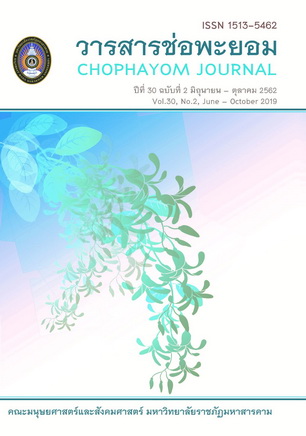Choreographic Invention Naga Principle Sattha Naga
Keywords:
choreographie, , Naga Principle, Sattha NagaAbstract
This research is produced to show believes, faiths, and phenomenon of Naga in Kham Chanod area, a Buddhist forest temple near Kham Chanod village in Udon Thani province, in order to create choreography. The purposes of this research are to study about the background of believers of Naga as Choreography, the idea of dance artists of choreographer in Kham Chanod area, however, to also create the performance, Fon Sattha Naga from the worksheet study and the data collection concluded from four knowledgeable people, 10 actors and actresses, and 10 local people using the existing tools such as surveying, observing and interviewing, and this research will be presented in descriptive analysis. The result of this research found that the Naga belief is important to those who are Thais and have lived alongside of Mekong River in northeastern Thailand. It’s because the local people have believed that Naga is gods or goddesses of the river, and marked as prosperity. According to studies, the numbers of oblations and the diversity of dance arts have been found in Kham Chanod area. These evidences have been produced from the entire believers of Naga in order to pay their respects. Finally, Kham Chanod has been addressed as the sacred area and
there has been told by generations to generations about its history. However, this area has become the diversity of dance arts. Regarding the creation of choreography related Naga history, the researcher team has used the principle of dance art in terms of determination of ideas, data processing, scoping, data determination, and defining other information consisted of costumes, instrument, and chorography to create the perfect and beautiful performance in Dancing Art. The belief and the faith in the sacred area have constructed the relationship between the area and the people, especially the performance Fon Sattha Naga, would become the phenomenon in Dancing Arts using to pay respect for the Naga as a custom tradition regarding the relation as mentioned. Keywords : choreography, Naga Principle, Sattha Naga
References
ฉัตรทิพย์ นาถสุภา (2541) วัฒนธรรมหมู่บ้านไทย. กรุงเทพ : สร้างสรรค์จํากัด.
ชัชวาล วงษ์ประเสริฐ. (2532). ศิลปะการฟ้อนภาคอีสาน. มหาสารคาม : สํานักงานวิทยบริการมหาวิทยาลัยศรีนครรินทรวิโรฒ มหาสารคาม.
ชาญณรงค์ พรรุ่งโรจน์. (2548) การวิจัยทางศิลปะ.. กรุงเทพฯ : สํานักพิมพ์แห่งจุฬาลงกรณ์มหาวิทยาลัย.
ชุมเดช เดชภิมล. (2521). ภาพสะท้อนชีวิตชาวอีสานจากหมอลํา. กรุงเทพฯ: ภาควิชาภาษาไทยคณะอักษรศาสตร์ มหาวิทยาลัยศิลปากร.
พิเชฐ สายพันธุ์. (2539). นาคาคติ อีสานลุ่มนํ้าโขง : ชีวิตทางวัฒนธรรมจากพิธีกรรมร่วมสมัย. วิทยานิพนธ์หลักสูตรสังคมวิทยาและมานุษยวิทยามหาบัณฑิต สาขามานุษยวิทยา คณะสังคมวิทยามหาวิทยาลัยธรรมศาสตร์.
พีรพงศ์ เสนไสย. (2557) นาฏยประดิษฐ์อีสาน มหาสารคาม : สาขานาฏศิลป์ คณะศิลปกรรมศาสตร์ มหาวิทยาลัยมหาสารคาม.
ภิญโญ จิตต์ธรรม. (ม.ป.ป.). ขนบธรรมเนียมประเพณีไทย. สงขลา : มงคลการพิมพ์.
สุจิตต์ วงษ์เทศ (2546) นาคในประวัติศาสตร์อุษาคเนย์. กรุงเทพ : มติชน.
สุรพล วิรุฬห์รักษ์ (2544). นาฏยศิลป์ปริทรรศน์. กรุงเทพฯ : ภาควิชานาฏศิลป์ คณะศิลปกรรมศาสตร์ จุฬาลงกรณ์มหาวิทยาลัย.
สุรพล วิรุฬห์รักษ์.(2543) นาฏยศิลป์ปริทรรศน์ กรุงเทพฯ : ภาควิชานาฏศิลป์ คณะศิลปกรรมศาสตร์ จุฬาลงกรณ์มหาวิทยาลัย.
อุรารมย์ จันทมาลา. (2555) ความเชื่อเรื่องนาคที่มีอิทธิพลต่อแนวคิดและรูปแบบการสร้างงานนาฏศิลป์ไทย วารสารคณะมนุษยศาสตร์และสังคมศาสตร์ มหาวิทยาลัยมหาสารคาม






